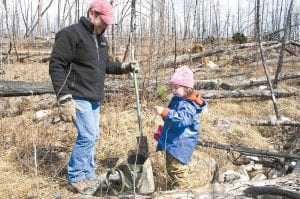Spring is on the way and a tradition that began the year after the 2007 Ham Lake wildfire is coming soon. The Ham Lake Fire area continues to heal and recover, four years after the fire, thanks to volunteer efforts. Participants are invited to register for the 2011 event at www.GunflintGreenUp.com to once again help with the greening up of the Gunflint Trail. Organizers have approximately 10,000 pine tree seedlings that will be planting this year on May 7 at Iron Lake, Round Lake, the Seagull boat landing and Chik-Wauk Museum and Nature Center.
According to organizers, planting is a little more work this year. Vegetation is beginning to grow back in many forms. In most areas, each seedling will require a small patch of earth be “scalped” to find good mineral soil.
Sue Weber, with the Cook County Visitor’s Bureau, said Gunflint Green Up might be changing a bit in years to come. Because the area is getting overgrown, it is hard for seedlings to survive. So future years may include more scalping of soil and releasing of alreadyplanted trees. “We’ll also be on the look-out for invasive plant species, and remove those where possible. And tree protectors—those coverings protecting planted trees from wildlife—will be removed in several areas.”
“We will absolutely continue this very popular spring event, but it may look different than its current form,” said Weber.
Gunflint Green Up begins on Friday, May 6, with Walks and Talks, and an evening dinner and presentation by historian Lee Johnson, Paulson Mine and the Port Arthur Duluth and Western Railroad: Collapse of the Gunflint Iron Range.
Saturday evening includes the celebratory dinner, and a return of our local Trail’s End Band for a dance in the wood chips.
To learn more about this year’s event or to register visit www.GunflintGreenUp.com or contact the Visitor’s Bureau at (218) 387-2788.
The Ham Lake Fire raged throughout the month of May 2007 and burned 118 square miles in Minnesota and Canada, and cost around $11 million to extinguish. The fire destroyed approximately 138 structures, ranging from sheds to cabin homes in Cook County. In 2008, the Ham Lake fire was rated the most destructive in Minnesota since 1918, but nobody was killed or seriously injured.



Loading Comments